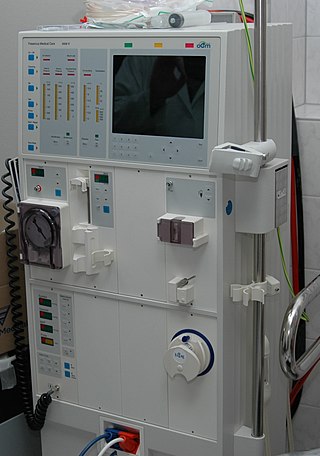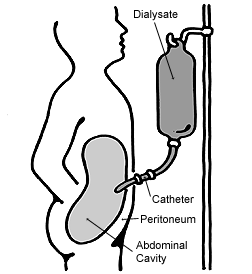
Kidney dialysis is the process of removing excess water, solutes, and toxins from the blood in people whose kidneys can no longer perform these functions naturally. This is referred to as renal replacement therapy. The first successful dialysis was performed in 1943.

Uremia is the term for high levels of urea in the blood. Urea is one of the primary components of urine. It can be defined as an excess in the blood of amino acid and protein metabolism end products, such as urea and creatinine, which would be normally excreted in the urine. Uremic syndrome can be defined as the terminal clinical manifestation of kidney failure. It is the signs, symptoms and results from laboratory tests which result from inadequate excretory, regulatory, and endocrine function of the kidneys. Both uremia and uremic syndrome have been used interchangeably to denote a very high plasma urea concentration that is the result of renal failure. The former denotation will be used for the rest of the article.

Renal functions include maintaining an acid–base balance; regulating fluid balance; regulating sodium, potassium, and other electrolytes; clearing toxins; absorption of glucose, amino acids, and other small molecules; regulation of blood pressure; production of various hormones, such as erythropoietin; and activation of vitamin D.

Hemodialysis, also spelled haemodialysis, or simply dialysis, is a process of filtering the blood of a person whose kidneys are not working normally. This type of dialysis achieves the extracorporeal removal of waste products such as creatinine and urea and free water from the blood when the kidneys are in a state of kidney failure. Hemodialysis is one of three renal replacement therapies. An alternative method for extracorporeal separation of blood components such as plasma or cells is apheresis.

Assessment of kidney function occurs in different ways, using the presence of symptoms and signs, as well as measurements using urine tests, blood tests, and medical imaging.

Peritoneal dialysis (PD) is a type of dialysis that uses the peritoneum in a person's abdomen as the membrane through which fluid and dissolved substances are exchanged with the blood. It is used to remove excess fluid, correct electrolyte problems, and remove toxins in those with kidney failure. Peritoneal dialysis has better outcomes than hemodialysis during the first couple of years. Other benefits include greater flexibility and better tolerability in those with significant heart disease.

Home hemodialysis (HHD) is the provision of hemodialysis to purify the blood of a person whose kidneys are not working normally, in their own home. One advantage to doing dialysis at home is that it can be done more frequently and slowly, which reduces the "washed out" feeling and other symptoms caused by rapid ultrafiltration, and it can often be done at night, while the person is sleeping.
Hemodialysis product (HDP) - is a number used to quantify hemodialysis and peritoneal dialysis treatment adequacy.
Artificial kidney is often a synonym for hemodialysis, but may also refer to the other renal replacement therapies that are in use and/or in development. This article deals mainly with bioengineered kidneys/bioartificial kidneys that are grown from renal cell lines/renal tissue.
In pharmacology, clearance is a pharmacokinetic parameter representing the efficiency of drug elimination. This is the rate of elimination of a substance divided by its concentration. The parameter also indicates the theoretical volume of plasma from which a substance would be completely removed per unit time. Usually, clearance is measured in L/h or mL/min. The quantity reflects the rate of drug elimination divided by plasma concentration. Excretion, on the other hand, is a measurement of the amount of a substance removed from the body per unit time. While clearance and excretion of a substance are related, they are not the same thing. The concept of clearance was described by Thomas Addis, a graduate of the University of Edinburgh Medical School.
The urea reduction ratio (URR) is a dimensionless number used to quantify dialysis treatment adequacy.
Standardized Kt/V, also std Kt/V, is a way of measuring (renal) dialysis adequacy. It was developed by Frank Gotch and is used in the United States to measure dialysis. Despite the name, it is quite different from Kt/V. In theory, both peritoneal dialysis and hemodialysis can be quantified with std Kt/V.

Frank A. Gotch was an American physician known for his work in renal dialysis adequacy, specifically the development of Kt/V and standardized Kt/V. He was an Associate Professor of Medicine at the University of California, San Francisco.
In nephrology, dialysis adequacy is the measurement of renal dialysis for the purpose of determining dialysis treatment regime and to better understand the pathophysiology of renal dialysis. It is an area of considerable controversy in nephrology.
In nephrology, the peritoneal equilibration test (PET), is a tool used by nephrologists to determine the characteristics of the peritoneal membrane mass transport characteristics, when assessing a patient for peritoneal dialysis.

Dialysis disequilibrium syndrome (DDS) is the collection of neurological signs and symptoms, attributed to cerebral edema, during or following shortly after intermittent hemodialysis or CRRT.

Robert Provenzano is an American nephrologist. He is also an Associate Clinical Professor of Medicine at Wayne State University School of Medicine.
Nathan W. Levin is an American physician and founder of the Renal Research Institute, LLC., a research institute dedicated to improving the outcomes of patients with kidney disease, particularly those requiring dialysis. Levin is one of the most prominent and renowned figures in clinical nephrology as well as nephrology research. He has authored multiple book chapters and over 350 peer-reviewed publications, including articles in leading journals such as Nature, the New England Journal of Medicine, and The Lancet.
Aluminium toxicity in people on dialysis is a problem for people on haemodialysis. Aluminium is often found in unfiltered water used to prepare dialysate. The dialysis process does not efficiently remove excess aluminium from the body, so it may build up over time. Aluminium is a potentially toxic metal, and aluminium poisoning may lead to mainly three disorders: aluminium-induced bone disease, microcytic anemia and neurological dysfunction (encephalopathy). Such conditions are more prominently observed in people with chronic kidney failure and especially in people on haemodialysis.
Qian Jiaqi, also romanized as Jia-Qi Qian, was a Chinese nephrologist and professor at Renji Hospital of Shanghai Jiao Tong University School of Medicine. He was the first clinical physician to perform hemodialysis and peritoneal dialysis in China, and established a Kt/V value of at least 1.7 as the target for peritoneal dialysis.



























